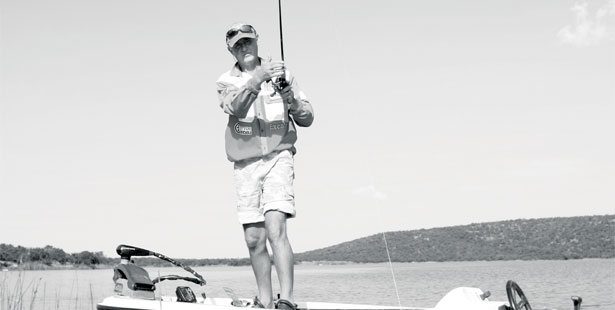Features
Extreme Bassing
- Details
- Written by Lionel Crow

After reading about “full contact fishing”I did some experimenting and was greatly rewarded. The suggestion was that on heavily pressured waters you have to look for fish in areas that other, less dedicated anglers overlook – such as extremely heavy cover. In the US this usually means that the angler kits himself out with helmets, knee pads, gloves and tough clothing, and then goes bashing his way through the bundus to areas where others won’t dare to go.
There are very few such areas around Kwazulu-Natal that would warrant such extremes, but dams such as Nandoni and Maguga spring to mind. There are areas however that others do not dare to go to in our waters, such as in the backwaters of reeds and grasses, fallen trees and heavy brush. You will be surprised at the bass that are found in these areas.
On one trip to Inanda, I managed to overcast slightly in the reeds on the right hand side of Rocky Bay and got my crank stuck deep inside them, so I approached the reeds and had to lift the sneaker to pull the boat inside to retrieve my crank. While inside I saw numerous big bass lying in small clearings in water of only about two foot deep. Using my regular jig rod and 14lb line I pitched into a couple of gaps but the bass just moved into the thicker reed where dropping jigs was tough and even tougher to retrieve, but I found that if it was possible to penetrate the reed, the bite was on, even though the bass were too big to get back out of the holes. But I squeezed the jigs through and often this meant pulling on the reeds with one hand to get the boat closer to free the hooked bass from the reeds or I would get broken off. I left that day determined to beat the odds the next time I returned.
A couple of days later I returned with a short 6.1’ heavy rod and 20lb line. The short rod was necessary as the reeds around the boat where about 2m tall and the longer rod proved a little difficult to maneuver, especially when trying to recover a fish. I also equipped myself with a long pole that I used to maneuver the boat around in the reeds. This proved very successful and I bagged some good fish in those same reeds as well as those around the campsite. I missed two good fish however that I reckon were well over 5kg, and they were at the campsite where I would least expect to see fish of that size cruising the reeds, areas where any bank or boat angler would not be able to get near to without some serious bundu bashing.
The water dropped over the next few weeks and my extreme bassing at Inanda was limited to practicing around Madhouse and up the left hand side of the river - but the water was rising fast and the right time would come.
A similar place that we have fished in this manner is at Albert Falls - at the entrance to the river both sides of the banks hold endless opportunities for bass that are not targeted by anglers who are unwilling to risk the paint job on the boat or the mass of tackle that can be lost while finding your feet at extreme fishing.
Rust de Winter is another dam that springs to mind - on a recent trip I was amazed at how many gaps there were at the back of the reeds, such as channels and holes made by the hippos, but in order to get to them the trolling motor and the main motor must be raised and the boat needs to be push poled through to get in a cast. It’s a lot of work but the rewards are great.
One thing to be careful of in these areas is not to damage the vegetation. Find paths or push yourself through without having to cut or break plants and damage bird’s nests and so on. These areas are usually haunts for juvenile fish and without these protected areas bass hatchlings wouldn’t stand a chance of survival, so be careful. Also on more than one occasion we have encountered snakes and crocs in the reeds as well, and if you put yourself in a situation where you can’t get out fast enough there could be some dire consequences - an angry hippo can do some nasty damage to you and your boat! So get to know the dam.
A most useful tool when targeting such areas is a pole to push the boat through the thick stuff. I first used a swimming pool pole but found it too weak and it bent easily. I managed to find a shepherd’s staff which served me well until it fell overboard - it was great for pulling and pushing and on many occasions it assisted in removing stuck lures. At the moment I’m using my oars, part of my safety equipment, but two joined together to give some extra length, and am designing an extendable pole, which is easy to store on my boat when not in use. Gloves are another tool worth looking into, as some of the reeds that need to be moved are sharp and cut your hands to pieces when trying to retrieve bass that are hung up, and if you are using braid will save your hands when having to yank free a snagged bait.
I mainly use the tour grade football jigs, usually in Bama Craw, Black, Brown or Candy Craw to which I add a trailer. My favourite trailer is the Denny Brauer Chunk in Brown with Copper Fleck, but have recently discovered the Chatterbait trailers which look like frog legs and have an awesome action, and these are fast becoming a favourite as well. Out of necessity I have developed a football jighead to which hooks can be added that allow the use of plastics that can be rigged almost snag free. For this I use floating worms.
The “Crow”jig as many have now named it, has an awesome action when used with the floating baits, especially in the reeds. The basic technique is to pitch it into the gaps, get the bait to drop to the bottom and then just twitch it or hop it back. The important thing is to make sure it has penetrated the reed as often it appears to have gone through but gets hung up just under the surface and you will be wasting your time, so watch the line. Detecting the bite can be tricky - it is important to watch the line, as sometimes the line only moves a slight amount as the bass takes it in but does not swim with it. Other times the bite is unmistakable.
Skipping baits into areas with heavy cover that you would not normally dare to try can also be productive. Inanda Dam has some excellent reeds around Dusi Point - to give you an idea these are reeds that have gaps from the side, and if your casting abilities are very good you can get a bait to skip right into the back of these gaps. Getting the bait to stay on the water and not skip up high into the air and become snagged is the main aim.
Tubes are also great for this style of fishing - detecting the bite is usually a lot easier because most of the time it will be smashed as it comes to rest on the surface. Tubes that can float and which are rigged properly are almost snag-free. I insert a small weight or a rattle into the nose of the tube, depending on whether I want it to stay on the surface or sink into the structure.
Weightless worms are another good bait for these areas - dropping them into gaps and allowing them to sink naturally seems to produce the best results. I like to rig them Wacky- style on a 1/0 circle hook. Even though they snag much easier than the conventional method of rigging them the action just seems to attract better quality fish.
There are numerous big fish to be caught in our waters, but the really big fish are wise and don’t seem to be in the areas we normally target, so try areas where you would not normally fish. Be different and just maybe you will run into the fish of a lifetime!


 Visit us our
Visit us our